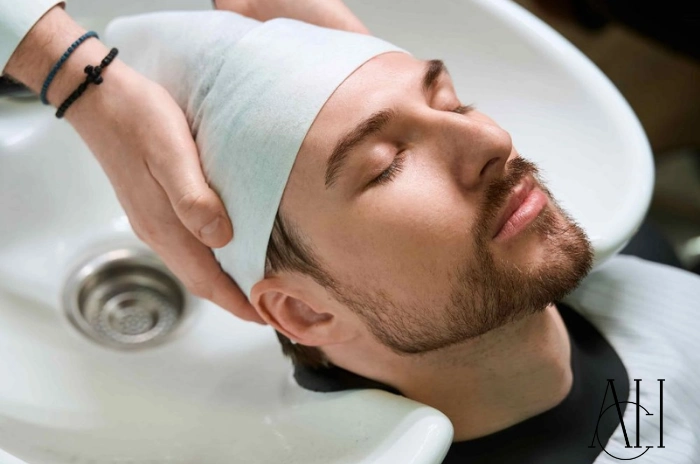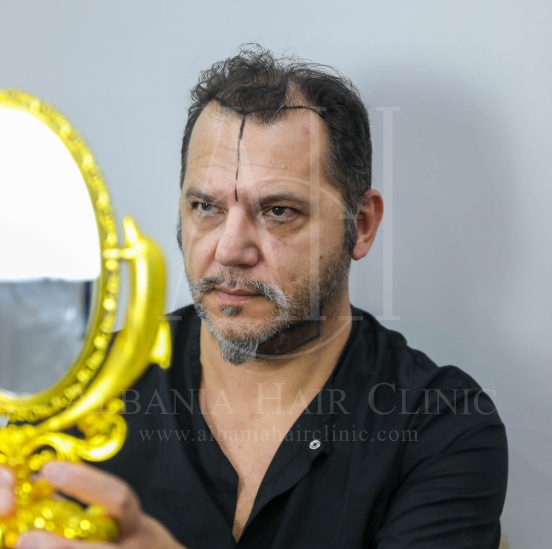Washing your hair after a hair transplant is one of the most important parts of the recovery process. Proper washing keeps the scalp clean, supports healing, and protects the newly implanted grafts. In this blog, you’ll learn when and how to wash your hair, which products to use, and what to avoid. Following the correct steps will help ensure the best results from your hair transplant. If done right, this simple step can improve graft survival and promote stronger hair growth.
Table of Contents
ToggleWhy Is It Important to Wash My Scalp After a Hair Transplant?
Supports Healing and Prevents Infection
Washing your scalp removes dried blood, crusts, and bacteria from the treated area. This reduces the risk of infection and keeps the scalp healthy. Clean skin helps the hair grafts settle and grow properly. A clean environment helps minimize inflammation and allows oxygen to reach the healing follicles.
Helps the Grafts Breathe
Proper washing clears the pores and allows the skin to breathe. This is especially important in the first few days when the area is sensitive and healing. Clogged pores can slow down recovery, so gentle washing plays a big role in aftercare.
After Hair Transplant, How Long Until I Can Wash My Hair?
Wait at Least 48 Hours
You should not wash your hair immediately after the surgery. Most doctors recommend waiting 2 to 3 days. This gives the grafts time to settle into the scalp. The scalp is very delicate right after surgery and needs time to begin healing before any water or products are applied.
Follow Your Clinic’s Advice
Always follow the instructions from your clinic or surgeon. Some may suggest a gentle rinse on day 3, while others may advise waiting a bit longer. Every transplant case is unique, so professional guidance ensures safety and effectiveness.
Albania Hair Clinic – Trapianto Capelli in Albania (@albaniahairclinic)’in paylaştığı bir gönderi
When Can I Wash My Hair After a Hair Transplant?
Gentle Wash on Day 3
Usually, a light wash can be done on the third day after the procedure. At this stage, you should not use strong water pressure or scrub your scalp. Light washing will help keep the scalp clean without disturbing the fragile grafts.
Daily Washing After the First Wash
After the first gentle wash, you may continue to wash your hair daily for about 7 to 10 days using a special shampoo provided by your clinic. This helps reduce crusting and keeps the transplanted area clean and moist.
Preparing for the First Hair Wash
Set Up a Comfortable Space
Get a small cup or bowl to pour water gently over your head. Avoid using direct shower pressure. A calm and clean space ensures you can focus on washing gently and safely.
Use the Right Products
Use only the shampoo and lotion given by your clinic. These are made to be soft on your healing skin and grafts. Harsh products can cause irritation and slow down healing, so follow your clinic’s recommendations closely.
Things to Pay Attention to During the First Hair Wash
Be Gentle
Do not rub or scratch the scalp. Use your fingertips lightly and dab the shampoo. Being too rough can damage the hair grafts and affect their ability to grow.
Rinse Slowly
Pour lukewarm water slowly with a cup or soft stream. Do not use hot water or strong flow. High pressure or heat can loosen grafts or irritate the healing skin.
How Soon Can I Wash My Hair After a FUE Transplant?
FUE Needs Careful Washing
After a FUE (Follicular Unit Extraction) transplant, washing is especially important. Wait 48 to 72 hours before the first wash. FUE grafts are delicate, so you must be extra gentle. This care supports the survival and growth of individual hair follicles.
Lotion First, Then Shampoo
Most FUE clinics suggest applying a moisturizing lotion before shampooing. This softens the crusts and makes washing easier. It also helps reduce tension on the grafted area during the wash.

Correct Timing for Washing Your Hair
Daily for 10 Days
Once you start washing, continue every day for 10 days. This helps remove scabs and keeps the area clean. Regular washing also improves circulation, which supports healing and hair growth.
Stop When Scabs Fall Off
After all the scabs fall off, you can return to a more normal hair washing routine. At this stage, the grafts are more secure and less likely to be disturbed.
How Do I Wash My Hair After a Hair Transplant?
Step-by-Step Guide
-
Apply moisturizing lotion: Leave it on for 20-30 minutes.
-
Rinse with lukewarm water: Pour slowly using a cup.
-
Apply shampoo: Gently dab it using your fingers.
-
Rinse again: Carefully remove shampoo without rubbing.
-
Dry carefully: Pat dry with a soft towel. Do not rub.
Avoid Hair Dryer
Let your hair dry naturally or use a cool setting on a hair dryer. Heat can damage healing skin. A gentle drying process helps avoid irritation and allows the scalp to recover smoothly.
How Often Should I Wash My Hair After the Hair Transplant?
Daily for the First 10 Days
Washing daily helps clean the scalp and remove crusts. It also prevents infection and supports healing. This is a vital part of your post-transplant routine and should not be skipped.
Switch to 3 Times a Week Later
After the first 10 days, reduce washing to 3 times a week or as advised by your clinic. A lighter washing schedule keeps the scalp clean without over-stimulating it.
What Care Products and Shampoos Should I Use?
Use Clinic-Approved Products
Always use the lotion and shampoo provided by your doctor. These are usually mild and made for sensitive scalp. They help hydrate the scalp and maintain a healthy pH level.
Avoid Harsh Chemicals
Do not use shampoos with perfume, alcohol, or strong chemicals. These can irritate the scalp and damage grafts. Organic or medical-grade hair care products are often recommended.
Why Does Proper Hair Washing Matter?
Promotes Healthy Growth
Good hygiene keeps the scalp clean and boosts blood flow. This supports the growth of the new grafts. A clean scalp also reduces itching and promotes overall comfort.
Reduces Risks
Improper washing may lead to infection, loss of grafts, or poor results. Taking care helps avoid these problems. It also improves the appearance of the transplant site during healing.
Should You Delay Washing Your Hair After a Hair Transplant?
Don’t Wait Too Long
While you must wait 2 to 3 days, you should not delay washing for too long. Waiting more than 5 days may allow crusts and bacteria to build up. This can interfere with healing and affect the success of the transplant.
Balance Is Key
Start gently and follow a regular schedule for the first 10 days. Ask your clinic if you have doubts. Timely washing combined with gentle technique is the best approach.

Risks of Washing Your Hair Transplant
Risk of Damaging Grafts
If you rub or scratch your scalp too early, the grafts may fall out or move. Be extra careful when washing. Graft loss at this stage can reduce the final density of your hair.
Risk of Infection
Using unclean water or hands may increase infection risk. Always wash hands and use clean water. Keep your towels and hair care items clean to prevent bacterial growth.
Additional Hair Transplant Aftercare Tips
Avoid Sunlight and Heat
Do not expose your scalp to direct sunlight or heat for the first two weeks. Use a loose hat if needed. UV rays can damage the healing skin and delay the growth phase.
No Smoking or Alcohol
Avoid alcohol and smoking for at least 7 days after surgery. They slow healing and affect graft survival. A healthy lifestyle improves your overall recovery and long-term hair results.
Follow Clinic Instructions
Your doctor may give you a detailed aftercare plan. Follow it strictly for the best results. These personalized instructions are based on your procedure and graft count.
Avoid Physical Activity
Do not go to the gym or play sports for at least 10 days. Sweating can increase the risk of infection. Excess motion and sweating may also disturb grafts or slow healing.
Washing your hair properly after a hair transplant is one of the most important parts of recovery. Gentle care, the right timing, and suitable products all help your scalp heal and your hair grow better. By following the tips in this step-by-step guide, you’ll protect your new grafts and improve your hair transplant results. Always ask your clinic if you’re unsure—and enjoy your journey to fuller, healthier hair! A clean and healthy scalp is the foundation for long-lasting transplant success.
Frequently Asked Questions
How soon can I wash my hair after a hair transplant?
It’s generally recommended to wait at least 48 hours before washing your hair to allow the transplanted grafts to settle. After this period, you can gently wash your hair using a mild, non-medicated shampoo as advised by your surgeon.
What is the proper technique for washing my hair post-transplant?
Begin by diluting a gentle shampoo with lukewarm water. Gently pour this over your scalp without rubbing or scrubbing. Use your fingertips to lightly pat the donor area, avoiding the recipient area. Rinse by pouring lukewarm water over your head, ensuring all shampoo residue is removed. Let your hair air dry; avoid using a towel on the recipient area.
How often should I wash my hair after the transplant?
Starting from day 4 to day 7 post-surgery, you can wash your hair once a day using the gentle technique described. After the initial healing period, typically by week 2, you can return to your normal hair-washing routine.
Can I use regular shampoo after my hair transplant?
It’s advisable to use a mild, non-medicated shampoo, such as baby shampoo, during the initial healing period. Your surgeon will provide specific recommendations based on your individual case.
What precautions should I take to avoid dislodging grafts while washing?
Avoid direct water pressure on the scalp; instead, use a cup or the showerhead on its lowest setting to rinse. Do not rub or scrub the scalp; gently pat it. Refrain from using hot water, and let your hair air dry without using a towel on the recipient area.




